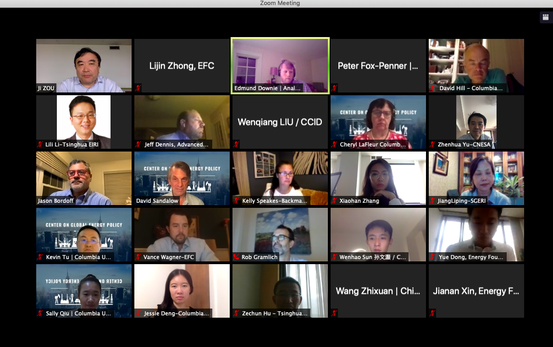Sino-U.S. Dialogue Sets Priorities for China’s Energy Storage Development
In mid-September, 2020, the Center on Global Energy Policy at Columbia University and Energy Foundation China convened an online Sino-U.S. energy storage policy dialogue. The event aims to shed light on the research priority into China’s future energy policy, by contrasting the experiences in the world’s two largest holders of installed energy storage capacity. Joined by over 50 leading experts from all over the world, the discussion covered five key areas in this field, namely, market structure, industrial policy, grid stability and decarbonization, public finance, and long-term development strategy.

Parts of the attendees of the online Sino-U.S. Energy Storage Policy Dialogue on September 11, 2020
Despite both facing a steadily growing demand, the U.S. and China energy storage markets have different characteristics. In terms of market nurturing, experts believed that the U.S. government supports the storage market mainly by improving the regulations of the electricity market, providing subsidies and tax incentives for investment. China, in contrast, although having issued favorable policies, offers few detailed implementation guides and has not yet created a conducive environment for the development of a storage industry. Given that China is still marketizing its power sector, the storage sub-market is yet to develop a mature pricing mechanism to afford diverse business models beyond simply profiting on peak-valley spread.
Noting the inadequacies, experts suggested further exploring the value of storage in power auxiliary services and transmission and distribution, improving the market mechanism for energy storage, enacting a pricing and bidding mechanism, and developing an appropriate payment mode for storage services.
Additionally, experts touched on the limitation of energy storage technology. Though it strengthens the case of building zero-carbon power grid, its role in system-wide decarbonization will be limited by market and policy challenges for commercializing long-duration energy storage technology, as long as practical technical bottlenecks continue to exist.
To boost the energy storage industry, experts pointed out that public finance should play the guiding role in building the development of storage and renewable energy infrastructure into other high-level strategies such as economic stimulus, poverty alleviation, and new urbanization. As for stimulating investment, the experts recommended encouraging China’s two major state-owned power grid enterprises to invest in energy storage resource access on the demand side, and taking advantage of development banks and policy banks to drive the financing for storage projects.
In terms of future strategy, the dialogue suggested to elevate the discussions on developing energy storage to integrating storage facility into renewable power system, specifically to focus on finding the appropriate payment mechanism, business model, and supporting policies.
Expert attended the dialogue include Cheryl LaFleur, former Commissioner of the Federal Energy Regulatory Commission; Jason Bordoff, founding Director of the Center on Global Energy Policy of Columbia University; David Sandalow, Inaugural Fellow of the Center on Global Energy Policy of Columbia University; Kelly Speakes-Backman, CEO of the U.S. Energy Storage Association; Wang Zhixuan, Vice President of the China Electricity Council; Jiang Liping, Vice President of the China State Grid Research Institute; Yu Zhenhua, Vice Chairman of the China Energy Storage Alliance; Liu Wenqiang, Vice President of the China Center for Information Industry Development; Zou Ji, CEO & President of Energy Foundation China; and 40 other participants from China, the U.S., and other countries.




